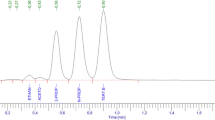Abstract
When rats were administered methyl isocyanate (MIC) by inhalation or subcutaneous route it produced severe hyperglycemia, clinical lactic acidosis, highly elevated plasma urea, and reduced plasma cholinesterase activity with unaltered erythrocytc acetyl cholinesterase activity. Irrespective of the route of administration, MIC also caused severe hypothermia, which was not ameliorated by prior administration of atropine sulphate. Acute toxic effects of MIC are essentially similar by either route except for the intensity of the effects.
Similar content being viewed by others
References
Barker SB, Summerson WH (1941) The colorimetric determination of lactic acid in biological material. J Biol Chem 138:535–54
Bhattacharya BK, Sharma SK, Jaiswal DK (1988)In vivo binding of [1-14C] methyl isocyanate to various tissue proteins. Biochem Pharmacol 37:2489–2493
Ellman GL, Courtney KD, Andres V Jr, Featherstone RM (1961) A new and rapid colorimetric determination of acetylcholinesterase activity. Biochem Pharmacol 7:88–95
Feldberg W, Myers RD (1964) Effects of temperature on amines injected into the cerebral ventricles. A new concept of temperature regulation 173:226–237
Ferguson JS, Schaper M, Stock MF, Weyel DA, Alarie Y (1986) Sensory and pulmonary irritation with exposure to methyl isocyanate. Toxicol Appl Pharmacol 82:329–335
Fowler EH, Dodd DE (1986) Acute inhalation studies with methyl isocyanate vapour: II Respiratory tract changes in guinea pigs, rats and mice. Fundam Appl Toxicol 6:756–771
Friedemann TE, Haugen GE (1943) Determination of ketoacids in blood and urine. J Biol Chem 147:415–42
Harrison GA (1947) cf Varley H (1969) Practical Clinical Biochemistry, Arnold-Heinemann Publishers (India) Pvt Ltd, New Delhi 4th Ed, p 159
Hultman E (1959) Rapid specific method for determination of aldosaccharides in body fluids. Nature (London) 183:108–109
Jeevarathinam K, Selvamurthy WS, Ray US, Mukhopadhyay S, Thakur L (1988) Acute toxicity of methyl isocyanate, administered subcutaneously in rabbits: Changes in physiological, clinico-chemical and histological parameters. Toxicology 51:223–240
Kolb WP, Savary JR, Troup CM, Dodd DE, Tamerius JD (1987) Biological effects of short-term, high concentration exposure to methyl isocyanate. VIIn vitro andin vivo complement activation studies. Environ Health Perspect 72:189–195
Kutty KM (1980) Biological function of cholinesterase. Clin Biochem 13:239–243
Lowry OH, Rosebrough NJ, Farr AL, Randal RJ (1951) Protein measurement with the folin phenol reagent. J Biol Chem 193:265–275
Meeter E, Wolthuis OL (1968) The effects of cholinesterase inhibitors on the body temperature of the rat. Eur J Pharmacol 4:18–24
Nemery B, Dinsdale D, Sparrow S, Ray DE (1985) Effects of methyl isocyanate on the respiratory tract of rats. Brit J Indust Med 42:799–805
Testa B, Jenner P (1976) OxidativeN-dealkylation in drug metabolism: Chemical and biochemical aspects. Marcel Dekker, New York, pp 82–97
Troup CM, Dodd DE, Fowler EH, Frank FR (1987) Biological effects of short-term, high concentration exposure to methyl isocyanate. II Blood chemistry and haematologic evaluations. Environ Health Perspect 72:21–28
Varley H, Gowenlock AH, Bell M (1980) Practical Clinical Biochemistry, Vol 1, William Heinemann Medical Books Ltd, London, 5th Ed, pp 758
Vijayaraghavan R, Kaushik MP (1987) Acute toxicity of methyl isocyanate and ineffectiveness of sodium thiosulphate in preventing its toxicity. Indian J Exp Biol 25:531–534
Author information
Authors and Affiliations
Additional information
For Part I see Jeevarathinamet al. (1988) Toxicology 51:223–240.
Rights and permissions
About this article
Cite this article
Jeevaratnam, K., Vijayaraghavan, R., Kaushik, M.P. et al. Acute toxicity of methyl isocyanate in mammals. II. Induction of hyperglycemia, lactic acidosis, uraemia, and hypothermia in rats. Arch. Environ. Contam. Toxicol. 19, 314–318 (1990). https://doi.org/10.1007/BF01054971
Received:
Revised:
Issue Date:
DOI: https://doi.org/10.1007/BF01054971



